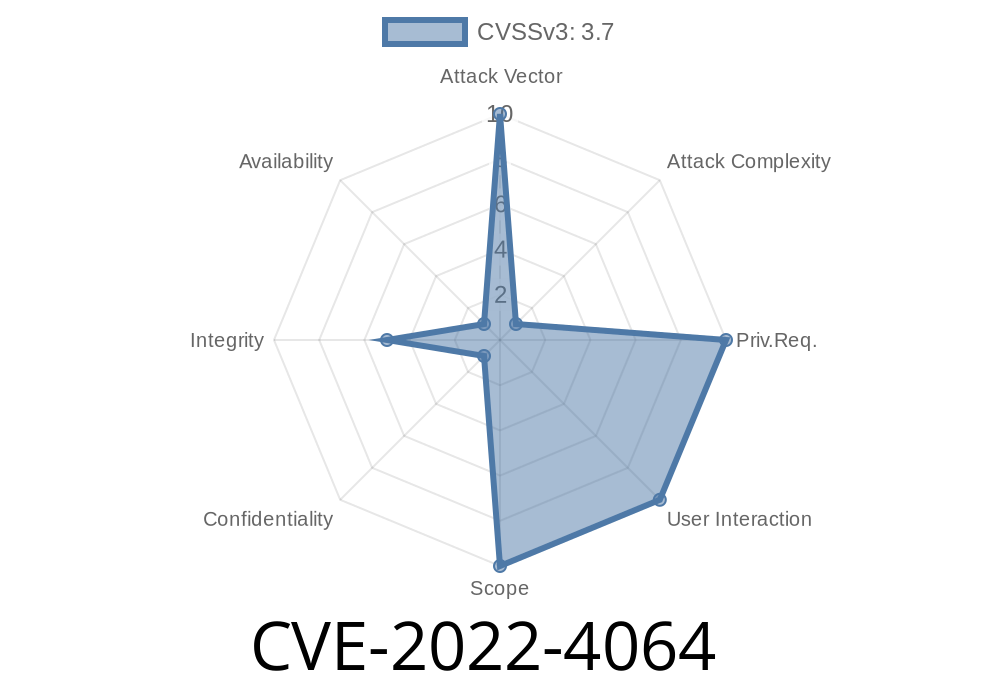Recently, a critical vulnerability was discovered in the Dalli library, which has been classified as a "problematic" security issue. This vulnerability impacts the self.meta_set function found in the lib/dalli/protocol/meta/request_formatter.rb file within the Meta Protocol Handler component. The vulnerability, known as an "injection" type issue, has been disclosed to the public, and as a result, there is a high probability for exploits to be developed and used by malicious actors. This blog post aims to shed light on the details of the CVE-2022-4064 vulnerability, the associated patch (48d594dae55934476fec61789e7a7c370ef50d), and provides guidance on how to protect your systems from potential exploitation.
Affected component: Meta Protocol Handler
The vulnerability specifically targets the Meta Protocol Handler component used in Dalli. Meta Protocol Handler is a crucial component that deals with metadata storage and retrieval in Dalli.
Affected function: self.meta_set
The vulnerability resides in the self.meta_set function of the lib/dalli/protocol/meta/request_formatter.rb file, which is responsible for handling metadata set requests in Dalli using the Meta protocol.
Here's a simplified version of the vulnerable code snippet
module Dalli
module Protocol
class Meta
module RequestFormatter
def self.meta_set(request, value)
# Vulnerable code...
end
end
end
end
end
Exploit details: Injection
The vulnerability allows an attacker to potentially inject malicious code into Dalli, which can then lead to several attack possibilities such as data theft, performance impact, or server compromise. This exploit can be triggered by adversaries who possess knowledge of the underlying Dalli library and understanding of Meta protocols.
The Public Disclosure and Patch
Upon uncovering this critical vulnerability, the developers behind Dalli immediately released patch 48d594dae55934476fec61789e7a7c370ef50d to address the issue. The patch specifically addresses the injection vulnerability in the self.meta_set function.
You can find the original patch information and vulnerability details here: github.com/petergoldstein
Vulnerability Database (VDB) has assigned the unique identifier VDB-214026 to this particular security issue.
Recommended Actions
To safeguard your systems from potential exploitation, it is strongly recommended to apply the patch as soon as possible. The following steps guide you through the process of applying the patch:
1. Check the current version of Dalli library in use on your system, and confirm if it is vulnerable to CVE-2022-4064.
2. Update the Dalli library to the latest patched version by following the official documentation: rubygems.org/gems/dalli
3. Ensure that the patch has been correctly applied by running test cases or validating the modification in the self.meta_set function in lib/dalli/protocol/meta/request_formatter.rb.
Following these recommendations will help protect your systems and data against potential exploitation of the CVE-2022-4064 vulnerability in Dalli.
Conclusion
The CVE-2022-4064 vulnerability in the Dalli library is a critical security issue that affects the Meta Protocol Handler component. Proper understanding and timely action to apply the patch will help safeguard your systems from potential exploits. Stay vigilant, and keep your software up-to-date to minimize the risk of security vulnerabilities.
Timeline
Published on: 11/19/2022 19:15:00 UTC
Last modified on: 11/26/2022 03:22:00 UTC
